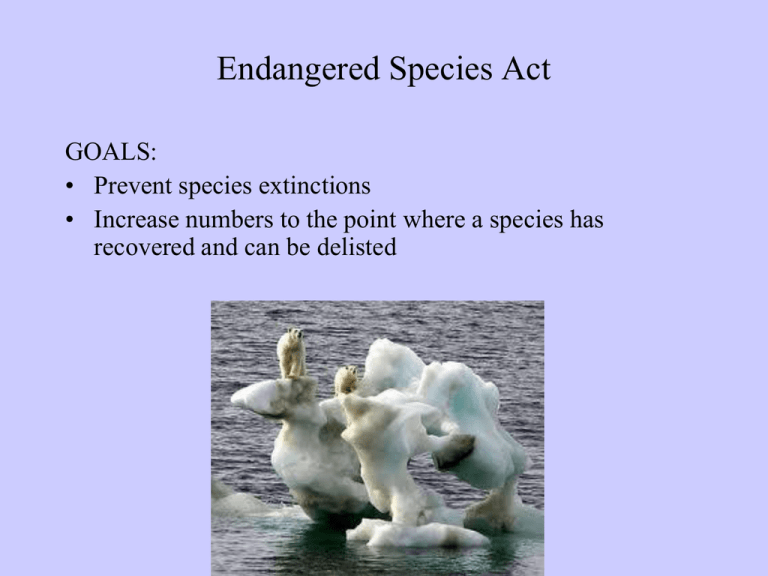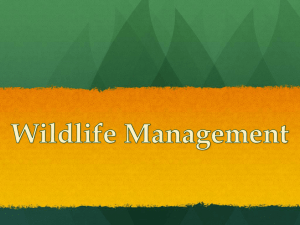Endangered Species Act
advertisement

Endangered Species Act GOALS: • Prevent species extinctions • Increase numbers to the point where a species has recovered and can be delisted Endangered Species Act • Protection of gene pools – Subspecies, evolutionary significant units • Protection of populations – Distinct population segments • • • • Protection of species Protection of habitat Recovery plans Incidental take permits – Habitat Conservation Plans Thylacine (Thylacinus cynocephalus) or Tasmanian wolf – extinct 1900s ESUs = distinct populations or groups of populations of vertebrates. 1. Population unit must be reproductively isolated from other populations of the same species to a significant extent. 2. Population unit must represent an important component in the evolutionary legacy of the species. Pacific coast coho salmon – Oncorhynchus kisutch Endangered Species Act • Protection of gene pools – Subspecies, evolutionary significant units • Protection of populations – Distinct population segments • • • • Protection of species Protection of habitat Recovery plans Incidental take permits – Habitat Conservation Plans Bajii, or Yangtze River dolphin – 2007? • USFWS (2007) listed Alabama sturgeon as distinct species rather than include it as part of the more populous shovelnose sturgeon. • Decision based on morphology, not on genetics (both species genetically identical). Alabama sturgeon - Scaphirhynchus suttkusi Endangered Species Act Established procedures for: • Listing species as • ‘threatened’ – likely to become endangered in the foreseeable future throughout all or a significant portion of its range, or • ‘endangered’ – at risk of extinction throughout all or a significant portion of its range. • Designating critical habitat. • Preparing recovery plans for listed species. Critical habitat USFWS must designate ‘critical habitat’ at the time of listing to the ‘maximum extent prudent and determinable’. Definition: the specific areas occupied by the species ‘on which are found those physical or biological features’ that are essential for its conservation and that ‘may require special management considerations or protection’. Monk seal, 1952 (declared extinct 2008) May include areas that the species does not occupy. Criteria for Listing 1. 2. 3. 4. 5. Present or threatened destruction or modification of the species’ habitat or range Overutilization for commercial, recreational, scientific or educational purposes Disease or predation Inadequate regulatory mechanisms Other factors affecting the species’ continued existence * Any interested person can petition USFWS to list species and start review process. Review must provide substantiative scientific information indicating listing may be warranted Recovery plans • Within 2.5 years of listing, a formal recovery plan must be completed • The goal is not only for protection, but to remove species from the brink of extinction • Must include: ‘Site-specific management actions’. ‘Objective, measureable criteria’ for evaluating recovery. Pyrenean ibex, 2000 Last female killed by falling tree Estimates of time and costs What does the ESA do? • Unlawful for any person subject to the jurisdiction of the US to engage in acts threatening to endangered and threatened species, including taking, possession, transportation, and sale • Taking is defined broadly to include harass, harm, pursue, hunt, shoot, wound, kill trap, capture, or collect, or attempt to engage in any such conduct. Does take = habitat destruction? • Palila v. Hawaii Dept. of Land and Natural Resources – Court ruled that when the State allowed sheep and goats on the slopes of Mauna Kea, the defoliation caused by browsing changed the habitat, endangered the Palila, and therefore constituted a take. Harm/harass • This changed the definition of harm and harass to: any intentional or negligent act or omission, including habitat modification, that creates the likelihood of injury to wildlife by annoying it to such an extent to significantly disrupt normal behavior patterns which include, but are not limited to breeding, feeding, or sheltering. Canadian oystercatcher, 1940 (declared extinct 1994) What happens if there are Endangered Species on your property? • Incidental take permits = Habitat Conservation Plans • Landowners may receive a permit to take imperiled species on their lands, provided that such takings were incidental to otherwise lawful activities (e.g., construction or timber harvest). A landowner must prepare an HCP that outlines how much take will occur as a result of the proposed activity and what steps would be taken to minimize and mitigate the effects. If HCP minimizes and mitigates to the maximum extent practicable, and that the taking is unlikely to jeopardize the continued survival and recovery of the species, then the HCP is approved and the permit is issued and the project may commence. What is an HCP? • Taking permitted on land if it will be incidental • The applicant will, to the maximum extent practicable, minimize and mitigate the impacts of the taking • The applicant will ensure that adequate funding for the plan will be provided • Taking will not appreciably reduce the likelihood of the survival and recovery of the species in the wild • …and other stuff… Components of a Habitat Conservation Plan • • • • • Status Take Impact Mitigation Monitoring The (dreaded) no surprises clause • Essentially, state and private landowners are assured that if “unforeseen circumstances” arise, the FWS will not require the commitment of additional land, water, or financial compensation or additional restrictions on the use of land, water, or other natural resources beyond the level otherwise agreed to in the HCP without the consent of the permit holder. Javan tiger, 1994 Criticisms of ESA • Decisions to list are not sufficiently timely and are subject to political pressure. • Animal species are afforded more protection than plants (plants and animals protected on federal lands, but only animals on private lands.) • Protects ‘distinct populations’ of vertebrates but not plants or invertebrates. Criticisms of ESA • Listing also favors vertebrates – invertebrates = 84% of all species in US and 1/3 or atrisk species, but only account for 14% of listed species. • Funding also favors vertebrates (especially iconic species) – 20 vertebrates in 2004 received >50% of funds;10% to all plants.







